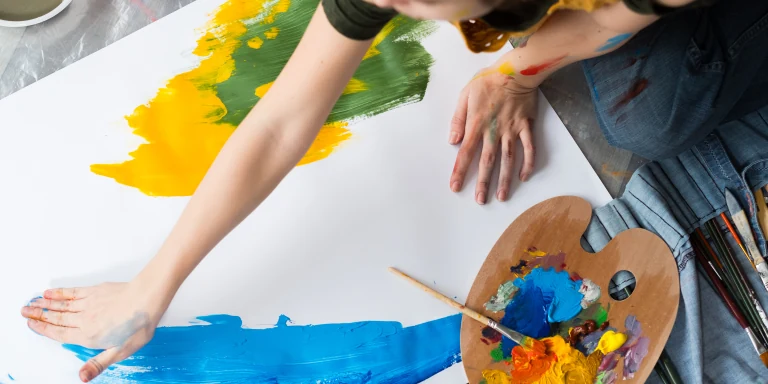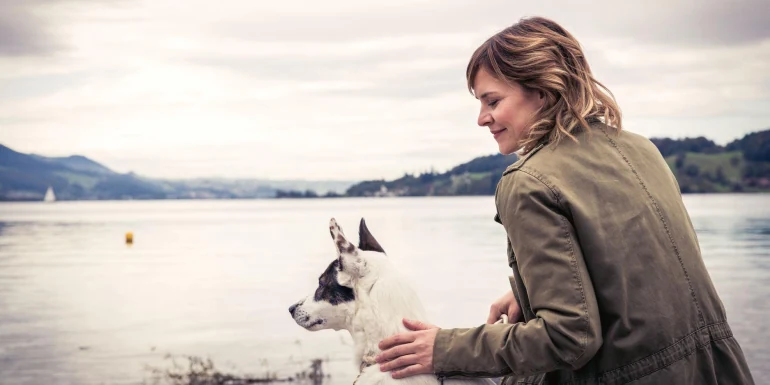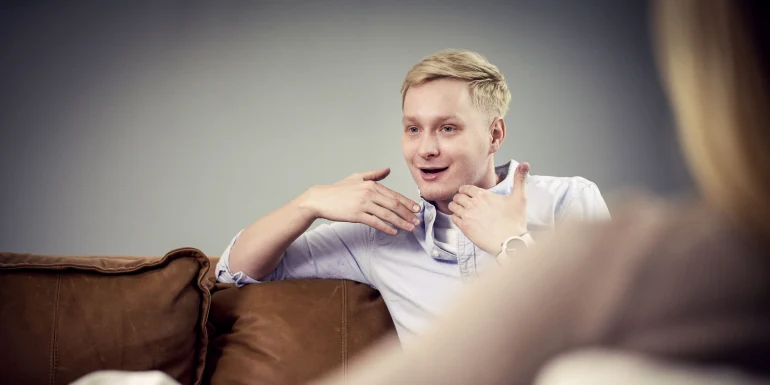
Art therapy for adults and children
Art therapy allows you to explore your feelings and express them creatively. Whether it’s painting in order to relax and cope with stress or art therapy to help with depression and anxiety – there are various objectives and possible forms of use.
What is art therapy?
Art therapy is a form of therapy where painting is used as a means of healing and self-discovery. When you create pictures, you can express feelings and thoughts that are difficult to articulate. In art therapy, you can get a better understanding of yourself and practise dealing with internal and external conflicts better – such as by representing them with shapes and colours and thereby gaining a new perspective.
Art therapy is a flexible method: irrespective of age, it offers a setting in which adults and children can get to know themselves better and work on personal issues or hardships.
What are the aims of art therapy?
In general, art therapy aims to identify emotional and psychological challenges through creative expression in the painting process.
Art therapy for children
Art therapy for children offers them a playful way of expressing themselves. Children understand their thoughts and feelings better and communicate them in a simple way, and learn to handle their fears and worries. They also discover their creative talents, which in turn boosts their self-confidence.
Art therapy for adults
Art therapy for adults often aims to reduce stress, promote relaxation and provide new perspectives. It offers the chance to escape from everyday worries and concentrate on the creative process. This allows you to clear your head and possibly find solutions to problems that are bothering you. This form of therapy offers you a protected environment where you can explore your thoughts and feelings with support from the therapist.
How much does art therapy cost?
The cost of art therapy varies depending on the therapist and the region. We contribute to the costs of special forms of treatment, including art therapy. With TOP supplementary insurance, you receive 75% of the costs up to a maximum of CHF 3,000 per calendar year. With COMPLETA supplementary insurance, you can even get up to CHF 4,500 per calendar year.
Art therapy for depression?
Art therapy gives you the chance to express yourself creatively in a safe and supportive environment. Painting offers a new way for you to visualise and communicate even complex emotions and states of mind. In turn, this can help you become aware of your own feelings and thoughts that may be linked to depression.
Art therapy also provides a relaxing break from everyday life, allowing you to lower your stress level. It can also boost your self-confidence by monitoring your progress over time. The creative freedom of art therapy enables you to overcome personal barriers and deal with your inner fears and worries. Art therapy also boosts self-confidence: you create your own artwork, choosing your own technique, colours and images.
Art therapy: What exercises are there?
There are many simple art therapy exercises that you can try at home. Just take a sheet of paper and a pen and visualise yourself in the external environment. Art therapy is a diverse field with different techniques that promote self-awareness and the expression of emotions. The various exercises in art therapy are designed to be both therapeutic and relaxing.
Art therapy offers a creative means of expression that can be even more effective in combination with other methods of relaxation. Breathing exercises for relaxation help you to focus on the painting process and reduce stress. More methods of relaxation such as yoga and mindfulness training allow you to gain a deeper level of self reflection during art therapy.
Emotional landscape
The emotional landscape is a revitalising method in art therapy that allows you to reflect on yourself and come to terms with your own feelings. With each brush stroke, you deepen your self-awareness and learn to deal with and accept certain emotions. Start by focussing on your current feelings. Which colours represent them? Which landscape could you use to express them? For example, you could paint a stormy scene if you are stressed, whereas a sunny forest clearing could represent joy.
Mood diary
A mood diary is a creative and intuitive technique allowing you to observe your emotional state and how it develops. Whichever painting technique and colours you choose, these represent the way you are and how you want to portray your inner world. Over time, a richly coloured chronicle of your emotional world is created. Art therapy helps you to identify emotional patterns and adapt your everyday life accordingly. You also take some time out every day to express your emotions creatively with colours and shapes.
Painting to music
When painting intuitively to music, you allow yourself to be guided by your sensations and feelings. There is no right or wrong. Rhythms and melodies serve as creative stimuli that you transfer straight onto the canvas or page. Spontaneously painting as ideas come to you allows you to express yourself in a genuine and undistorted way. This exercise in art therapy can have a liberating effect and encourage self-reflection: it allows you to externalise your own emotions and helps you to recognise them.
Power animal
Find an undisturbed and pleasant place where you feel comfortable. Take three deep breaths, in and out. Close your eyes and visualise your personal power animal. A power animal is like a reliable companion that gives you strength. Let your power animal appear inside your mind. Paint it and try to find out what meaning it has for you.
Heart
First of all, draw a heart. Think about what satisfies your heart the most and divide it into different areas. Label these with the most important things in your life, for example family and friends. Personalise them as you wish. The size and colour of the areas are up to you. You can also use small sketches if you like. This exercise will help you focus on what matters most to you.
Art therapy offers you many ways of exploring your emotions. Take some time out to relax, try out the various exercises and get to know yourself a bit better. It’s not about creating a piece of work to be judged or criticised. It’s more about allowing your inner world to show itself.
The expert provided the editorial team with advice and input for this article. Tina Annunziata Lella (intensive and palliative care nurse) works for Helsana as a Health Advisor.


Newsletter
Find out more about current health issues every month and get all the information you need about our attractive offers from all Helsana Group companies * delivered by e-mail to read whenever it suits you. Our newsletter is free of charge and you can sign up here:
We did not receive your information. Please try again later.
* The Helsana Group comprises Helsana Insurance Company Ltd, Helsana Supplementary Insurances Ltd and Helsana Accidents Ltd.